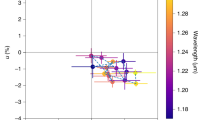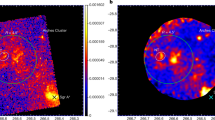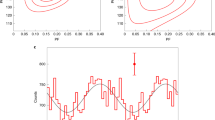Abstract
Close binary systems often show linear polarization varying over the binary period, usually attributed to light scattered from electrons in circumstellar clouds1,2,3. One of the brightest close binary systems is Spica (alpha Virginis) consisting of two B-type stars orbiting with a period of just over four days. Past observations of Spica have shown low polarization with no evidence for variability4,5,6. Here we report new high-precision polarization observations of Spica that show variation with an amplitude of about 200 parts per million. By including polarized radiative transfer in a binary star model, we show that the phase-dependent polarization is mainly due to light reflected from the primary component of the binary system off the secondary component and vice versa. The stars reflect only a few per cent of the incident light, but the reflected light is very highly polarized. The polarization results show that the binary orbit is clockwise and the position angle of the line of nodes is 130.4° ± 6.8°, in agreement with intensity interferometer results7. We suggest that reflected light polarization may be much more important in binary systems than has previously been recognized and may be a way of detecting previously unrecognized close binaries.
This is a preview of subscription content, access via your institution
Access options
Access Nature and 54 other Nature Portfolio journals
Get Nature+, our best-value online-access subscription
$29.99 / 30 days
cancel any time
Subscribe to this journal
Receive 12 digital issues and online access to articles
$119.00 per year
only $9.92 per issue
Buy this article
- Purchase on Springer Link
- Instant access to full article PDF
Prices may be subject to local taxes which are calculated during checkout



Similar content being viewed by others
Data availability
All processed data generated during this study are included in this published article (the reduced observational data points are in Supplementary Table 4 and plotted in Fig. 1), and the raw data files are available upon reasonable request. All other data analysed in this work comes from public repositories: where this is the case, the origin of the data is indicated in the text.
Code availability
Our modelling code is based on the publicly available ATLAS9, SYNSPEC and VLIDORT codes. Our modified version of SYNSPEC and our binary modelling code is available on request.
References
Brown, J. C., McLean, I. S. & Emslie, A. G. Polarisation by Thomson scattering in optically thin stellar envelopes. Astron. Astrophys. 68, 415–427 (1978).
Rudy, R. J. & Kemp, J. C. A polarimetric determination of binary inclinations: results for five systems. Astrophys. J. 221, 200–210 (1978).
Berdyugin, A., Piirola, V., Sakanoi, T., Kagitani, M. & Yoneda, M. High-precision broad-band linear polarimetry of early-type binaries. II. Variable, phase-locked polarization in triple Algol-type system λ Tauri. Astron. Astrophys. 611, A69 (2018).
Pfeiffer, R. J. & Koch, R. H. On the linear polarization of close binaries. Publ. Astron. Soc. Pacif. 89, 147–154 (1977).
Tinbergen, J. Interstellar polarization in the immediate solar neighbourhood. Astron. Astrophys. 105, 53–64 (1982).
Elias, N. M., Koch, R. H. & Pfeiffer, R. J. Polarimetric measures of selected variable stars. Astron. Astrophys. 489, 911–921 (2008).
Herbison-Evans, D., Hanbury-Brown, R., Davis, J. & Allen, L. R. A study of alpha Virginis with an intensity interferometer. Mon. Not. R. Astron. Soc. 151, 161–176 (1971).
Bailey, J. et al. A high-sensitivity polarimeter using a ferro-electric liquid crystal modulator. Mon. Not. R. Astron. Soc. 449, 3064–3073 (2015).
Bailey, J., Cotton, D. V. & Kedziora-Chudczer, L. A high-precision polarimeter for small telescopes. Mon. Not. R. Astron. Soc. 465, 1601–1607 (2017).
Cotton, D. V. et al. The linear polarization of southern bright stars measured at the parts-per-million level. Mon. Not. R. Astron. Soc. 455, 1607–1628 (2016).
Rudy, R. J. & Kemp, J. C. Phase-locked polarization in u Herculis: evidence for the reflection mechanism. Astrophys. J. 216, 767–775 (1977).
Berdyugin, A. V. & Harries, T. J. Discovery of the variable phase-locked polarization in LZ Cephei. Astron. Astrophys. 352, 177–181 (1999).
Cotton, D. V. et al. Polarization due to rotational distortion in the bright star Regulus. Nat. Astron. 1, 690–696 (2017).
Eddington, A. S. The reflection effect in eclipsing variables. Mon. Not. R. Astron. Soc. 86, 320–327 (1926).
Russell, H. N. Idealized models and rectified light-curves for eclipsing variables. Astrophys. J. 108, 388–412 (1948).
Castelli, F. & Kurucz, R. New grids of ATLAS9 model atmospheres. Preprint at http://arXiv.org/abs/astroph/0405087 (2004).
Hubeny, I., Stefl, S. & Harmanec, P. How strong is the evidence of superionization and large mass outflows in B/Be stars? Bull. Astron. Inst. Czech. 36, 214–230 (1985).
Spurr, R. J. D. VLIDORT: a linearized pseudo-spherical vector discrete ordinate radiative transfer code for forward model and retrieval studies in multilayer scattering media. J. Quant. Spectrosc. Radiat. Transf. 102, 316–342 (2006).
Wilson, R. E. & Devinney, E. J. Realization of accurate close-binary light curves: application to MR Cygni. Astrophys. J. 166, 605–619 (1971).
Wilson, R. E. Eccentric orbit generalization and simultaneous solution of binary star light and velocity curves. Astrophys. J. 234, 1054–1066 (1979).
Harrington, D. et al. Alpha Virginis: line-profile variations and orbital elements. Astron. Astrophys. J. 590, A54 (2016).
Tkachenko, A. et al. Stellar modelling of Spica, a high-mass spectroscopic binary with a β Cep variable primary component. Mon. Not. R. Astron. Soc. 458, 1964–1976 (2016).
Palate, M., Koenigsberger, G., Rauw, G., Harrington, D. & Moreno, E. Spectral modeling of the α Virginis (Spica) binary system. Astron. Astrophys. 556, A49 (2013).
Van Leeuwen, F. Validation of the new Hipparcos reduction. Astron. Astrophys. 474, 653–664 (2007).
Marshall, J. P. et al. Polarization measurements of hot dust stars and the local interstellar medium. Astrophys. J. 825, 124 (2016).
Cotton, D. V. et al. The intrinsic and interstellar broad-band linear polarization of nearby FGK dwarfs. Mon. Not. R. Astron. Soc. 467, 873–897 (2017).
Bailey, J. The Dawes Review 3: the atmospheres of extrasolar planets and brown dwarfs. Publ. Astron. Soc. Aust. 31, e043 (2014).
Duchene, G. & Kraus, A. Stellar multiplicity. Ann. Rev. Astron. Astrophys. 51, 269–310 (2013).
Chapellier, E. et al. Has alpha Vir ever stopped pulsating? Astron. Astrophys. 143, 466–468 (1985).
Balona, L. A. On the amplitude decrease of the beta Cephei stars Spica and 16 Lacertae. Mon. Not. R. Astron. Soc. 217, 17–21 (1985).
Odell, A. P. Possible polarization effects in the beta Cephei stars. Publ. Astron. Soc. Pacif. 91, 326–328 (1979).
Bailey, J. & Kedziora-Chudczer, L. Modelling the spectra of planets, brown dwarfs and stars using VSTAR. Mon. Not. R. Astron. Soc 419, 1913–1929 (2012).
Bailey, J., Kedziora-Chudczer, L. & Bott, K. Polarized radiative transfer in planetary atmospheres and the polarization of exoplanets. Mon. Not. R. Astron. Soc. 480, 1613–1625 (2018).
Espinosa Lara, F. & Rietord, M. Gravity darkening in binary stars. Astron. Astrophys. 547, A32 (2012).
Acknowledgements
The work was supported by the Australian Research Council through Discovery Project grants DP140100121 and DP160103231. We thank the staff at the AAT for their support of our HIPPI observing runs. We thank R. Spurr of RT Solutions for providing the VLIDORT software.
Author information
Authors and Affiliations
Contributions
All authors participated in the observations of Spica and commented on the manuscript. D.V.C. developed the data reduction code, carried out the data reductions, ran the ATLAS9 models and investigated Spica’s interstellar polarization. J.B. developed the binary system and polarized radiative transfer codes, carried out the modelling, and prepared the manuscript.
Corresponding author
Ethics declarations
Competing interests
The authors declare no competing interests.
Additional information
Journal peer review information: Nature Astronomy thanks J. Patrick Harrington and the other anonymous reviewer(s) for their contribution to the peer review of this work.
Publisher’s note: Springer Nature remains neutral with regard to jurisdictional claims in published maps and institutional affiliations.
Supplementary information
Supplementary Information
Supplementary references, Supplementary Figures 1–4, Supplementary Tables 1–4.
Rights and permissions
About this article
Cite this article
Bailey, J., Cotton, D.V., Kedziora-Chudczer, L. et al. Polarized reflected light from the Spica binary system. Nat Astron 3, 636–641 (2019). https://doi.org/10.1038/s41550-019-0738-7
Received:
Accepted:
Published:
Issue Date:
DOI: https://doi.org/10.1038/s41550-019-0738-7
This article is cited by
-
Polarimetric detection of non-radial oscillation modes in the β Cephei star β Crucis
Nature Astronomy (2021)



